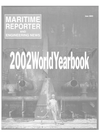
World Shipbuilding to Fall Slightly
Last year was an active one for the international shipbuilding market. Although the order intake was significantly reduced from the order boom of the previous year, 46 million dwt, or 31.3 million compensated gross tons (cgt) of new ships were ordered. Part of this can be explained by the order mix of tanker tonnage.
While large tankers were ordered last year, the average size this year declined from 130,000 dwt to 91.000 dwt, resulting in a higher cgt figure.
Total delivered from yards building tonnage larger than 30.000 dwt increased from 24.7 million cgt in 200 to 27.6 million cgt in 2001. At the beginning of the year, very few slots were reported to be available in Japan and Korea for 2003 delivery. During the year several slots which had previously been committed became available. As a result, a large proportion of the tonnage ordered during the latter part of the year secured delivery slots within 2003.
In spite of a reasonably balanced supply and demand situation, prices tended to slide over the year. This could be attributed to diminishing demand towards the end of the year and a depreciation of Korean Won and Japanese Yen. The Won fell approximately 14 percent, and the Yen 13 percent against the Dollar.
Korean shipbuilders continue to dominate the world shipbuilding market, delivering 9.6 million cgt in 2001, with container vessels accounting for 42 percent of that total. Tankers and bulkers amounted to 28 percent and 21 percent, respectively.
Of all new orders in 2001 awarded to yards capable of building 30,000 dwt and above, 38 percent went to Korean shipbuilders in terms of cgt, a decline from 46 percent the previous year. German owners were most active in ordering new tonnage in Korea, representing 43 percent The demand for new ships is expected to decline in 2002. In the tanker segment, much of the 88 million dwt needed for replacement within 2007 in accordance with IMO regulations is already included in the 62 million dwt large orderbook. The world shipbuilding capacity was at the end of the year 2001 fully booked throughout 2003. From 2004 onwards the industry should, however, have more than sufficient capacity to build the remaining 26 million dwt required under the phase out plan. The container market is not going to provide any relief either, as it is expected to suffer a bit in 2002 as well, with 700,000- teu due for delivery during the year. The LNG market, on the other hand, is expected to proceed at a quickened pace, as there are still LNG projects, which have not yet covered their shipping needs. The number of new orders is, however, not expected to reach the record high level set in 2001. Another segment that shows promise is the bulk market, fueled by anticipated improvement in the freight market. R.S. Platou expects ordering activity to increase somewhat from the previous year's 8.4 million dwt level.
Overall, R.S. Platou estimates that the shipbuilding capacity will grow by two percent on average per annum over the coming years, expressed in cgt. China has ambitious plans for expansion, and is expected to increase its building capacity significantly.
Source: The preceding was excerpted, in part, from The Platou Report 2002. R.S. Platou Shipbrokers A.S. is headquartered in Oslo, Norway, and can be contacted by: tel: +47 23 11 20 00: fax: +47 23 11 23 00; or on the Worldwide Web al www.platou.com.
Other stories from June 2002 issue
Content
- Bollinger To Acquire Halter Marine page: 6
- Bidding War Comes to an End page: 6
- Jotun And NOF Marine Coatings Join Forces page: 8
- Thunder Horse Will Get Wartsila Generators page: 10
- United Defense to Acquire United States Marine Repair page: 10
- New Order For MAN B&W Diesel ME-Engines page: 12
- Fares Al Salam Parts The Red Sea page: 14
- Redundancy The Next Watchword? page: 20
- Cargo Handling's New Force page: 22
- A Naval Architect's Look At Design Trends page: 24
- Conoco Leads The Way For GOM Shuttle Tankers page: 27
- Daewoo Shipbuilding To Build, Refit LNGs For Exmar page: 27
- Navy League Comes to NY for Centennial Celebration page: 28
- Prospects Abound, But Where's the Money? page: 32
- OPA '90 - The Oil Pollution Act of 1990 page: 33
- Container & RoRo Tonnage — Non-Contiguous Liner Trades page: 35
- Matson Signs $220M Contract With Kvaerner Philadelphia page: 38
- GL: Exporting German Precision page: 40
- World Shipbuilding to Fall Slightly page: 44
- Tanker Market is Solid page: 45
- Bergesen Releases 1Q Results page: 46
- OMI Announces 1Q Results page: 47
- MAN B&W Turbocharger Technology Unveiled page: 49
- Answering the Call from Above page: 50
- Thrane & Thrane Offers Capsat Fleet77 page: 53
- Crisis Management and the Integration of Vessel Tracking Technologies page: 60
- Rear Admiral Pluta Redefines Maritime Security page: 64
- Ship Graveyard page: 68
- Intertanko's Sustainable Challenge page: 72
- German Barging: Over the Divide page: 76
- Blohm+Voss: 125 Years Young page: 80
- Thordon Makes Inroads With COMPAC Shaft Bearing page: 90
- Halifax Lays Keel For First of Two OSV's page: 91
- Owners Approve White Rose Oilfield page: 91
- Voyage Data Recorders page: 92
- Titan Re-Floats IMaersk La Guaira page: 96
- Austal USA Enters Repair Market page: 96
- Maritime Industry Remembers Nealis page: 97

